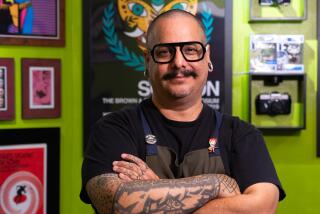Portrait of the Artist as an Angry Outsider
Manuel Ocampo has so many projects in the works that his calendar ought to belong to an artist twice his 28 years. In addition to his current show at Salander O’Reilly/Fred Hoffman Galleries in Beverly Hills--featuring Spanish colonial style paintings that combine images from editorial cartoons, old propaganda posters and illustrations of human freaks with German inscriptions--he is planning solo exhibitions at Mexico City’s OMR Gallery in October and at the University of Washington’s Henry Art Gallery in February.
Two museum group shows are on his agenda: “The 43rd Corcoran Biennial Exhibition of Contemporary American Painting,” opening in October at the Corcoran Gallery of Art in Washington, and “Equal Rights and Justice: 30 Years and Counting,” opening next May at Atlanta’s High Museum. He also has been commissioned to produce a 10-by-20-foot mural for the Yerba Buena Gardens Visual Arts Center in San Francisco, before its October opening.
A Filipino who came to the United States in 1986 and resides in Los Angeles, Ocampo has garnered more critical notice and publicity than most artists get in a lifetime. Snapped up by dealer Fred Hoffman--who discovered his work in the LACE Bookstore booth at the 1990 contemporary art fair at the Los Angeles Convention Center--Ocampo made a big splash in 1991 when Hoffman first presented his paintings.
As one of 16 artists in the Museum of Contemporary Art’s much talked-about 1992 exhibition “Helter Skelter: L.A. Art in the ‘90s,” he was once again in art-world news. And when some of Ocampo’s paintings, which included swastikas, were censored last summer in “Documenta IX” (a prestigious international exhibition in Kassel, Germany), he became a world-famous artist.
Even when his work isn’t involved in raging controversies, the subject matter of his paintings incites comment. In his current show (through May 15), he has painted such bizarre scenes as a Last Supper attended by drug-addicted rats, a chicken that carries a cross and has Christ’s head, a hooded warrior riding a big black bird and a ring of freakish “historical” characters with Why I Hate Europeans emblazoned above their heads.
One would never guess all this from Ocampo’s shy demeanor, or from the way he talks about himself. “My work comes from my feeling about my position as an outsider and having a voice that nobody listens to,” he said. “I’m not in the white boys’ club and I’m not in the club of minorities who want to be white boys. I’ve had a lot of exposure, but I still feel that people dismiss me, and I don’t have a dialogue with other artists.”
He considers himself “the outsider of the group” of artists in “Helter Skelter,” though he admires them all, particularly Chris Burden. As for the brouhaha at “Documenta IX,” the experience may have furthered his career but he didn’t want his work to be censored, he said.
Like the swastikas, which he painted to call attention to the symbol’s meaning, many images in his works are misinterpreted, he said. “It’s only a coincidence when people understand your work. People can never really understand what you are trying to say.”
It is tempting to read his paintings as a scathing commentary on contemporary issues of religion, politics and racism, but Ocampo does not intend his work to be a political or moral statement, he said. He is more interested in the fact that human ills never appear to change, and that images that are several centuries old can be adapted to art that looks old but is perceived as being right up to the minute.
Ocampo, who studied art at the University of the Philippines and at Cal State Bakersfield, tried editorial cartooning, abstract painting and other approaches to art during his formative years. He has captured critical attention in part because of his skillful use of the debased Spanish colonial style in artworks that deal with issues of cultural domination and identity.
The style is familiar to him from Catholic churches in the Philippines and from calendars his mother used to hang at home, he said, but Spanish colonial is also a foreign import that he views as exotic.
There’s more to his choice of style than childhood associations or a fascination with exoticism, however. “When I started painting in the Philippines, I worked for a man who produced paintings in the Spanish colonial style and sold them as antiques,” Ocampo said. “After I tried other ways of painting, I went back to the style I used in my job. I think it’s ironic that I’m now selling my work to Europeans.”
More to Read
The biggest entertainment stories
Get our big stories about Hollywood, film, television, music, arts, culture and more right in your inbox as soon as they publish.
You may occasionally receive promotional content from the Los Angeles Times.










